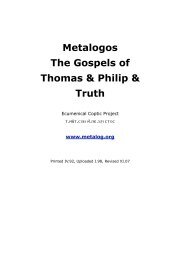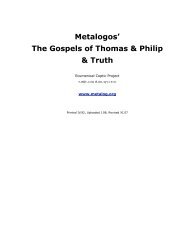Andrew Louth - Syriac Christian Church
Andrew Louth - Syriac Christian Church
Andrew Louth - Syriac Christian Church
Create successful ePaper yourself
Turn your PDF publications into a flip-book with our unique Google optimized e-Paper software.
INTRODUCTION 53<br />
theandric) activity’. According to all the manuscripts of the Corpus<br />
Areopagiticum that we possess, this letter in fact refers to ‘a new<br />
theandric activity’, and this is the reading Maximus knows and uses<br />
as the basis for his exposition. But since all the Greek manuscripts of<br />
the Dionysian writings go back to the edition prepared by John of<br />
Scythopolis in the middle of the sixth century, and John was himself<br />
anxious to present Denys as an orthodox Cyrilline Chalcedonian, the<br />
authenticity of the Monophysite/Monenergist/Monothelite reading ‘one<br />
theandric activity’ cannot be ruled out.<br />
Amb. 5 consists of a lengthy paraphrase of Denys the Areopagite’s<br />
fourth letter. In this letter Denys explains that in the Incarnation God<br />
is called human, not as being the cause of humanity (which is the<br />
ground of ‘cataphatic’ theology, in accordance with which God can be<br />
called everything of which he is the cause, that is, everything that is),<br />
but because ‘he is himself in his whole being truly a man’. Denys then<br />
goes on to explain how in the Incarnation there is a comherence of<br />
divine and human, so that Christ does human things divinely and<br />
divine things humanly, and thus manifests ‘a certain new theandric<br />
activity’. It is not difficult to suspect Denys’ language of deliberately<br />
contradicting the Tome of Leo with its assertion that ‘each form<br />
does what is proper to it in communion with the other’. It is hardly<br />
surprising that those who rejected the Tome of Leo called in support of<br />
their position this letter of Denys’. Maximus’ paraphrase is intended<br />
to show that the fourth letter is entirely in accordance with<br />
Chalcedonian orthodoxy. It is, however, Chalcedonian orthodoxy read<br />
in the light of Cyril—Cyrilline Chalcedonianism. Nowhere is this more<br />
apparent than in the interpretation of Jesus’ walking on the water—<br />
listed by Leo as an example of an unequivocably divine activity—<br />
where Maximus seems to be following Severus of Antioch (entirely<br />
unwittingly, one imagines, given his habitual denunciation of the<br />
Monophysite patriarch): ‘if then with unmoistened feet, which have<br />
bodily bulk and the weight of matter, he traversed the wet and unstable<br />
substance, walking on the sea as on a pavement, he shows through<br />
this crossing that the natural energy of his own flesh is inseparable<br />
from the power of his divinity’ (1049BC: and see my note ad loc.). For<br />
the rest Maximus insists on the integrity of the human nature<br />
assumed by the divine Person. He spells out, in accordance with the<br />
Chalcedonian Definition, that the human nature of Christ included a<br />
human soul, and was in every way like ours, save for sin. He also cites<br />
his favourite Christological text from Gregory the Theologian about the<br />
natures being ‘instituted afresh’, applying this first to the virginal<br />
conception, and then to the new form that the activity of the Incarnate<br />
One takes (his principal example being the walking on the water,<br />
already mentioned). But even as he explains how, in the Incarnation,




